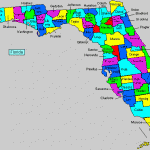Even with the boom slowing, Florida still grew 17 percent in the last decade and will gain additional congressional clout, getting two more seats in Congress, Census officials announced Tuesday.
 Now slated to hold 27 seats in the 435 member House, Florida continues a trend that began in 1930 by gaining at least one congressional seat during each of the past nine decennial redistributions of political power in a nation that continued to grow to the west and south.
Now slated to hold 27 seats in the 435 member House, Florida continues a trend that began in 1930 by gaining at least one congressional seat during each of the past nine decennial redistributions of political power in a nation that continued to grow to the west and south.
Florida, with 18,801,310 residents as of April 1, remained the fourth most populous state. It will have the same number of seats in Congress as No. 3 New York, behind No. 2 Texas, which gained four seats – the most of any state – and California which saw no gain in congressional power, but remains the nation’s largest state.
The biggest growth over the decade was in Nevada, which grew 35.1 percent, Census Director Robert Groves said in a conference call. Michigan was at the other end of the spectrum, with declines in auto making and other industries making it the only state to decline in population in the decade, losing at 0.6 percent of its population.
Nationally, the population revelation looked like continuing good news for Republicans, who made major gains in the November election, and now will gain congressional seats in several Southern and Western states that are generally considered more red than blue. The states losing population are mostly northeastern and Rust Belt states that have traditionally voted more Democratic.
The exact location of Florida’s two new congressional seats – and what they will look like and who they will include – now will be up to state legislators, who are scheduled to redraw the districts during the 2012 legislative session. How, exactly, the process will work this time around isn’t totally clear because of a new constitutional requirement that lawmakers not create districts that favor incumbents or a particular political party.
“Now the work begins in the Florida Legislature as we draw new congressional districts as well as seats in the Florida House and Senate,” said Senate President Mike Haridopolos, R-Merritt Island. “This will be a deliberative process and all Floridians will have a voice.”
The change also has implications for future presidential elections, because it increases the clout of growing states – Southern and Western states – in the Electoral College, while reducing the strength of traditionally Democratic states like New Jersey, Michigan and New York.
Florida will now have 29 Electoral College votes.
“Already a ‘must win state’ for presidential candidates, Florida becomes even more important with the addition of two more electoral votes as a result of gaining two more U.S House seats,” Sen. Don Gaetz, R-Niceville, and the chairman of the Senate Reapportionment Committee, said in a statement.
The U.S. population on April 1 was reported as 308.7 million, reflecting a 9.7 percent increase since 2000. That’s the slowest growth since the 1930s, according to the Census Bureau.
New York and Ohio each lose two congressional. States losing single seats are Iowa, Illinois, Missouri, Pennsylvania, Louisiana, Massachusetts, Michigan and New Jersey.
The Census Bureau is constitutionally required to reapportion congressional seats every 10 years to give all 435 congressional districts roughly the same population. Under the new apportionment, the average population of a congressional district will be 710,767, compared with 646,942 in 2000.
By Michael Peltier
The News Service of Florida


